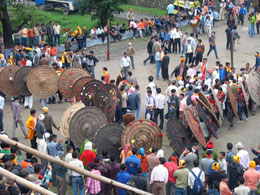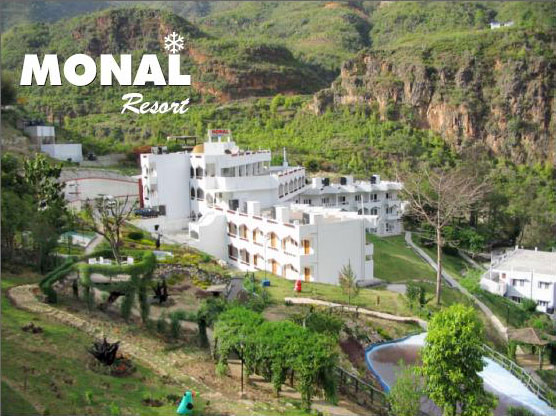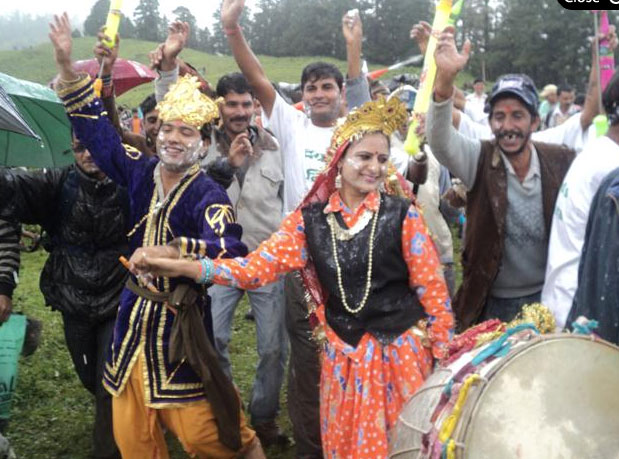Fairs and Festivals of Uttarakhand
The fairs and folk festivals of Uttarakhand are very colourful and distinctive, and are the blend of various natural, social and cultural factors. The people of Uttarakhand also celebrate all the major Indian festivals. Basant Panchami, Bhitauli, Harela, Phooldei, Batsavitri, Ganga Dusshera, Dikar Puja, Olgi or Ghee Sankranti, Khatarua, Ghuian Ekadashi and Ghughutia are some of the major festivals of Uttarakhand.
The daily lives of Uttarakhandi women are crowded with a never-ending succession of festivals, most of them involving fasts and the preparation of special foods.
Explore more about the folk festivals of Uttarakhand-
Makar Sankranti (Ghughutia)
According to the Hindu religious texts, on the day of Uttarayani, the sun enters the Zodiacal sign of 'Makar' (Capricon) from the Zodiacal sign of the Kark (Cancer), i.e. from this day onwards the sun becomes 'Uttarayan' or it starts moving to the north. It is said that from this day, which signals a change of season, the migratory birds start returning to the hills. On Makar Sankranti people give Khichadi (a mixture of pulses and rice) in charity, take ceremonial dips in holy rivers, participate in the Uttarayani fairs and celebrate the festival of Ghughutia or Kale Kauva.
Basant Panchami
The festival of Basant Panchami celebrates the coming of the spring season. This festival, which also signals the end of winter, is generally celebrated during Magh (January - February). During this festival people worship the Goddess Saraswati, use yellow handkerchiefs or even yellow cloths and in a few places people put a yellow tilak on their foreheads.
Phool Dei
Phool Dei is celebrated on the first day of the month of Chaitra in mid March and on this day young girls conduct most of the ceremonies. In some places this festival is celebrated throughout the month with the advent of spring.
Harela and Bhitauli
On the first day of the navaratris (nine day holy period) of the month of Chaitra women fill baskets with soil and sow seven types of grains in them. The grains germinate symbolizing the future harvest. These yellow leaves, called Harela, are cut on the tenth day and people put them on their heads and behind their ears. During the month of Chaitra (March-April) brothers send presents to their sisters. These presents are called Bhitauli.
Olgia or Ghee Sankranti
Olgia is celebrated on the first day of Bhado (middle of August), when the harvest is lush and green, vegetables are in abundance and the milch animals very productive. In ancient times sons-in-law and nephews would give presents to fathers-in-law and maternal uncles, respectively, in order to celebrate Olgia.
NandaDevi Rajjaat Yatra
The three week long Nandadevi Rajjaat is one of the world famous festival of Uttarakhand. People from entire Garhwal-Kumaon as well as other parts of India and the world participate in Nandadevi Rajjaat Yatra.
Goddess Nanda Devi is worshipped at dozens of places in Kumaon, but the region around Mt. Nanda Devi and its sanctuary, which falls in the districts of Pithoragarh, Almora and Chamoli, is the prime area related to Nanda Devi. In Chamoli Nanda Devi Rajjaat is organized once in 12 years. The jaat starts from Nauti village near Karnprayag and goes upto the heights of Roopkund and Haemkund with a four horned sheep.
Hilljatra
The Hilljatra, which is being celebrated in some parts of Pithoragarh district, is essentially the festival of pastoralists and agriculturalists. In the developmental process, the aathon (eighth day of bhado) and Gawra Visarjan also became the part of Hilljatra. The festival, which basically came to the Sor valley from the Sorar (Mahakali) region of West Nepal, was first introduced in Kumaour village. The Jatra was also accepted by the people of Bajethi, another village near Pithoragarh town and with some modifications it was introduced in Kanalichhina and Askot regions as Hiran chital.
Kandali
In the Chaudans region of Pithoragarh district, a flower - Kandali (Strobilenthes wallichii) - blooms once every 12 years (last in 1999) and the people celebrate Kandali festival between the months of August and October. The Chaundas Valley is remote in the Dharchula tehsil of Pithoragarh. It lies between the Kali and the Dhauli rivers. In the week long festival the local people - Shaukas or the Rangs participate with gaiety and enthusiasm in different villages of the region. Some stories are associate with this festival, which express the martial tradition of the Shaukas. In the first story, it is said that by tasting the poisonous flower of the Kandali the only son of a widow died. In the second story, this flower the symbol of famine and poverty. According to the third and most popul< story, the region was once attacked while the menfolk were away for trade. Th brave women repelled the enemy, who hid in the Kandali bushes, and the attacked the bushes and destroyed the enemy. The festival commemorates thei bravery and the women therefore destroy the plant ceremonially to remind th local people of the incident and to prevent further mishaps.
Khari Holi and Baithaki Holi
The uniqueness of the Kumaoni Holi lies in its being a musical affair, whichever may be its form, be it the Baithki Holi, the Khari Holi or the Mahila Holi. The Baithki Holi and Khari Holi are unique in that the songs on which they are based have touch of melody, fun and spiritualism. These songs are essentially based on classical ragas. No wonder then the Baithki Holi is also known as Nirvan Ki Holi. The Baithki Holi begins from the premises of temples, where Holiyars (the professional singers of Holi songs) as also the people gather to sing songs to the accompaniment of classical music.
Khatarua
Khatarua is essentially the special festival of pastoral- agricultural society and celebrated on the first day of the month of Ashwin in mid September, and signifies the beginning of the autumn. On this day people light bonfires, around which children dance, holding aloft colourful flags. People take special care of their animals and feed them fresh grass. Cucumbers are offered to the fire of Khatarua, which is said to destroy all evil influences. The victory of the king of Kumaon is also said to be one of the reasons for the celebration of Khatarua.
Ganga Dusshera or Dasar
Ganga Dusshera is celebrated on the Shukla dasami of the Jyestha (May - June). The sacred Ganga is worshipped on this day and Dusshera posters (dwarpatras or dasars), which have various geometric designs on them, are put up on the doors of houses and temples. These posters, once hand written by brahmins, are now printed. On this day people bathe in the holy rivers.
Janopunyu
The people of Kumaon celebrate Raksha Bandhan and J anopunyu, the day on which people change their janeu (sacred thread). On this day the famous Bagwal fair is held at Devidhura in district Pithoragarh.
Bat Savitri
This festival is celebrated on the Krishna amavasya (last day of the dark half of the month) of Jyestha and on the day married women worship Savitri and the Bat or banyan tree (Ficus benghalensis) and pray for the well being of their spouses. Women observe fast in honour of Savitri and Satyavan and remember how Savitri through her intense devotion saved her husband from the claws of death.
Jauljibi And Thal Fairs
This fair is held every year in November at Jauljibi, the confluence ofthe rivers Kali and Gori, which is a meeting place of three different cultures - the Shauka, the Nepali and the Kumaoni. This gateway to Johar, Darma, Chaudans and Byans was at one time, considered to be the central place between Tibet and the Tarai regions. Though this fair is primarily a commercial one, its cultural importance cannot be overlooked. People come even from Nepal to this fair in order to sell horses, ghee and foreign goods and take back foodgrains, jaggery etc. A similar fair is held at Thai on Vaishakh Sankranti (14 April) and it attracts a large number of Shaukas. With the closure of the Indo - Tibet trade these fairs have lost their former importance.
The Uttarayani Fair
This fair is held in a number of places including Bageshwar, Rameshwar, Suit Mahadev, Chitrashila (Ranibagh) and Hanseshwar etc. on Uttarayani day. At Pancheshwar the dola of Chaumu comes down to the temple. The fair at Bageshwar attracts maximum people. Its commercial, cultural and political importance is still very high. Goods like iron and copper pots, baskets, casks, bamboo articles, mats, mattresses, carpets, blankets, herbs and spices are sold during this fair.
The Nandadevi Fair
The Nandadevi fair is held at Almora, Nainital, Kot (Dangoli), Ranikhet, Bhowali, Kichha and also in the far flung villages of lohar (like Milam and Martoli) and Pindar valleys (like Wachham and Khati). In the villages of the Pindar valley people celebrate the Nanda Devi Jaat (journey) every year, while in lohar people come from far and wide to Danadhar, Suring, Milam and Martoli in order to worship the Goddess. In Nainital and Almora thousands take part in the procession carrying the dola (or litter) of Nanda Devi. It is said that the Nanda Devi fairs started in Kumaon during the reign of Kalyan Chand in the 16th Century.
Syalde Bikhauti
It is celebrated on the Vishuwat Sankranti day and commemorates an ancient victory. On this day, the Bagwal is held at Syalde Pokhar in the old town of Dwarahat. People also celebrate the occasion with music, songs and dancing. One day before this a similar fair is held at Vibhandeshwar in which Lord Shiva is worshipped. The Syalde Bikhauti fair has been successful in retaining its old colour and gaiety to a large extent.
The Somnath (Masi) Fair
This fair, also on Vishuwat Sankranti day is held in the Shiva temple at Masi. It is a famous fair of Pali Pachhaun. Animals, specially bullocks and calves, are sold at this fair. On the same day a fair is held at ThaI. In the summer the people in the valley of Ramganga W., especially in Masi and Bhikiasen, celebrate the unique machhli utsav (the fish festival). The villagers bearing tumra come with Jaal, fatyav and hathiya to the river to catch fish. The fish festival is locally known as Dahau.
The Devidhura Fair
This fair is held in the compound of the Varahi Devi temple at Devidhura on the day of Raksha Bandhan. Devidhura is situated at a trijunction of Almora, Pithoragarh and Nainital districts and the fair is well known for its enchanting folk songs and dances as also for its Bagwal. During the Bagwal the two groups (khams) of people throw stones at each other while they try to protect themselves by using big roof like shields. Even watching the Bagwal is a truly thrilling experience. The Devidhura fair has maintained its old vigour.
The Jageshwar Fair
This fair is held on the fifteenth day of the month of Baishakh (late March or early April) at the Shiva temple in Jageshwar. During the fair people take holy dips in the Brahma Kund (pool) and worship Lord Shiva. On this day, fairs are also held in many other places.
The Punyagiri Fair
Many people throng the temple at Punyagiri, which is situate,d on the top of a mountain on the right bank of the river Kali, in the district of Pithoragarh. The temple is very crowded during the Navaratris of Paush and Chaitra. Every year a fair is held on Vishuwat Sankranti and this attracts a large number of pilgrims. After the Holi festival, the longest fair of Kumaon (for about 40 days) starts at Punyagiri. Thousands of people visit the shrine these days.
The Haatkalika Fair
On the ashtami (eighth day of the month)of the Chaitra and Bhado, a fair is held in the Kalika temple at Gangolihat. People come with drums and flags to pay homage to Goddess Kalika. On this day, animals are sacrificed and offered to the Goddess. The athwar (eight sacrifices) processions with drums and dances are worth seeing.



